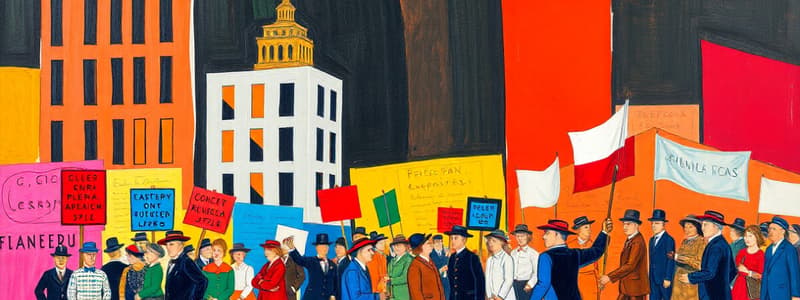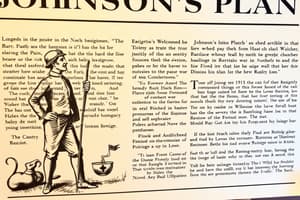Podcast
Questions and Answers
What was the main objective of the Reconstruction era?
What was the main objective of the Reconstruction era?
- To establish a strong national government
- To resolve the issue of slavery once and for all
- To expand westward and acquire new territories
- To rebuild the South and integrate former slaves into society (correct)
Which of the following Amendments protected voting rights for African Americans?
Which of the following Amendments protected voting rights for African Americans?
- 14th Amendment
- 15th Amendment (correct)
- 13th Amendment
- 16th Amendment
What was a significant challenge faced by the federal government during Reconstruction?
What was a significant challenge faced by the federal government during Reconstruction?
- The rise of Black Codes in the South (correct)
- The lack of qualified individuals to lead the reconstruction process
- The strong opposition from Northern states
- The lack of resources to fund rebuilding efforts
Which of the following best describes the shift in Reconstruction policies?
Which of the following best describes the shift in Reconstruction policies?
What marked the end of federal intervention in the South and allowed white Southerners to regain control?
What marked the end of federal intervention in the South and allowed white Southerners to regain control?
What business model did John D. Rockefeller use to dominate the oil refining industry?
What business model did John D. Rockefeller use to dominate the oil refining industry?
What was a common consequence of the rise of Big Business during the late 19th century?
What was a common consequence of the rise of Big Business during the late 19th century?
What was a major factor contributing to the decline of the Reconstruction era?
What was a major factor contributing to the decline of the Reconstruction era?
What was one major goal of labor unions like the Knights of Labor and the AFL?
What was one major goal of labor unions like the Knights of Labor and the AFL?
What event is associated with significant violent repression faced by the labor movement?
What event is associated with significant violent repression faced by the labor movement?
What was a consequence of the Dawes Act of 1887 for Native Americans?
What was a consequence of the Dawes Act of 1887 for Native Americans?
Which doctrine did the Supreme Court establish in Plessy v. Ferguson (1896)?
Which doctrine did the Supreme Court establish in Plessy v. Ferguson (1896)?
What was a major issue for farmers during the Gilded Age related to currency?
What was a major issue for farmers during the Gilded Age related to currency?
How did political machines like Tammany Hall operate during the Gilded Age?
How did political machines like Tammany Hall operate during the Gilded Age?
What was a significant outcome of the 1896 presidential election?
What was a significant outcome of the 1896 presidential election?
What was a major consequence of Jim Crow laws established in the 1890s?
What was a major consequence of Jim Crow laws established in the 1890s?
What major development characterized the emergence of the 'New South' after Reconstruction?
What major development characterized the emergence of the 'New South' after Reconstruction?
What was one of the main reasons for the political stalemate during the Gilded Age?
What was one of the main reasons for the political stalemate during the Gilded Age?
Flashcards
Reconstruction Era
Reconstruction Era
The period from 1865 to 1877 focused on rebuilding the South and integrating freed African Americans.
13th Amendment
13th Amendment
A constitutional amendment that abolished slavery in the United States.
14th Amendment
14th Amendment
Grants citizenship to all persons born or naturalized in the U.S. and ensures equal protection under the law.
15th Amendment
15th Amendment
Signup and view all the flashcards
Black Codes
Black Codes
Signup and view all the flashcards
Compromise of 1877
Compromise of 1877
Signup and view all the flashcards
Vertical Integration
Vertical Integration
Signup and view all the flashcards
Horizontal Integration
Horizontal Integration
Signup and view all the flashcards
Labor Unions
Labor Unions
Signup and view all the flashcards
Knights of Labor
Knights of Labor
Signup and view all the flashcards
American Federation of Labor (AFL)
American Federation of Labor (AFL)
Signup and view all the flashcards
Great Railroad Strike of 1877
Great Railroad Strike of 1877
Signup and view all the flashcards
Pullman Strike of 1894
Pullman Strike of 1894
Signup and view all the flashcards
Jim Crow Laws
Jim Crow Laws
Signup and view all the flashcards
Plessy v. Ferguson
Plessy v. Ferguson
Signup and view all the flashcards
Dawes Act of 1887
Dawes Act of 1887
Signup and view all the flashcards
The Gilded Age
The Gilded Age
Signup and view all the flashcards
Cross of Gold Speech
Cross of Gold Speech
Signup and view all the flashcards
Study Notes
Reconstruction Era (1865-1877)
- Reconstruction aimed to rebuild the South and integrate formerly enslaved people into society.
- Key legislative achievements: 13th, 14th, and 15th Amendments (abolishing slavery, granting citizenship, protecting voting rights).
- Amendments laid groundwork for future civil rights movements but faced Southern resistance and lack of federal enforcement.
- Reconstruction highlighted federal government's role in protecting citizens' rights.
- Reconstruction policies shifted from lenient (Lincoln, Johnson) to more radical (Congressional control).
- Reconstruction Acts (1867) placed the South under military rule.
- Reconstruction ultimately failed to achieve its goals, ending with the Compromise of 1877 and the re-establishment of Southern control with segregation and disenfranchisement.
Rise of Big Business and Labor Unions (Late 19th Century)
- Rise of big business, driven by industrialists like Rockefeller, Carnegie, and Morgan.
- These industrialists employed vertical and horizontal integration to dominate industries.
- Rockefeller's Standard Oil and Carnegie's steel empires exemplify these strategies.
- Businesses sought to maximize profits, eliminate competition, and gain monopolistic control.
- Workers faced harsh conditions, low wages, and long hours.
- Labor unions (Knights of Labor and AFL) emerged to advocate for better working conditions, shorter hours, and higher wages.
- Labor movement faced violent repression from employers and government.
- Strikes (Great Railroad Strike of 1877, Homestead Strike of 1892, Pullman Strike of 1894) highlighted the growing conflict between labor and management.
- Labor movement struggled due to internal divisions and difficulties in achieving lasting success.
Emergence of the "New South" and Jim Crow (Post-Reconstruction)
- Southerners sought to modernize the "New South" economically (industry growth).
- New South was rooted in racial inequality.
- White Southerners maintained control using segregation and disenfranchisement.
- Systems like crop-lien and sharecropping kept many in poverty.
- Jim Crow laws (1890s) institutionalized segregation in public spaces.
- Tactics to circumvent the 15th Amendment (literacy tests, poll taxes, grandfather clauses) disenfranchised African Americans.
- Plessy v. Ferguson (1896) legitimized segregation with "separate but equal."
- Federal government's policies negatively impacted Native Americans, leading to land loss and assimilation policies like the Dawes Act (1887).
- Native American resistance culminated in conflicts like Battle of Little Bighorn and Wounded Knee Massacre.
The Gilded Age (1865-1900) and Political Stalemate
- Gilded Age characterized by economic and social inequality.
- Political issues centered around the money supply, particularly for struggling farmers.
- Debate over gold vs. silver currency was prominent, with farmers advocating for silver coinage.
- 1896 presidential election highlighted the tension, with Bryan's "Cross of Gold" speech and McKinley's pro-gold stance.
- Political corruption (spoils system, political machines like Tammany Hall) exacerbated the issues.
- Big business influence meant lack of regulation and monopolies.
- Polarization and weak presidential leadership contributed to legislative gridlock.
- These conditions set the stage for the Progressive Era reforms.
Studying That Suits You
Use AI to generate personalized quizzes and flashcards to suit your learning preferences.



